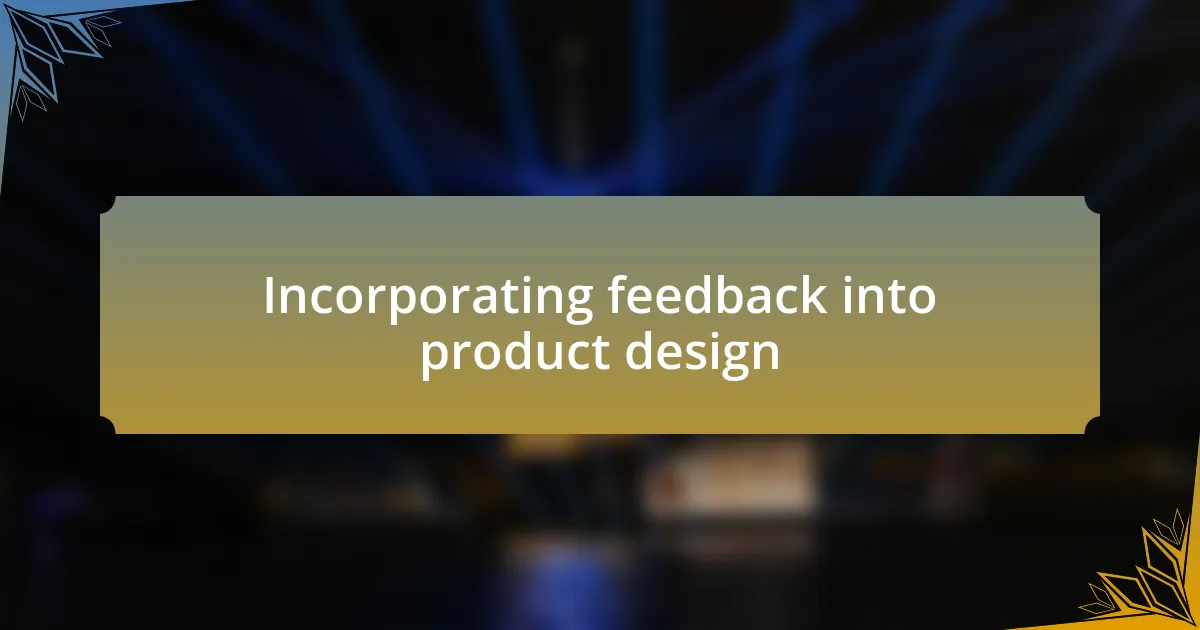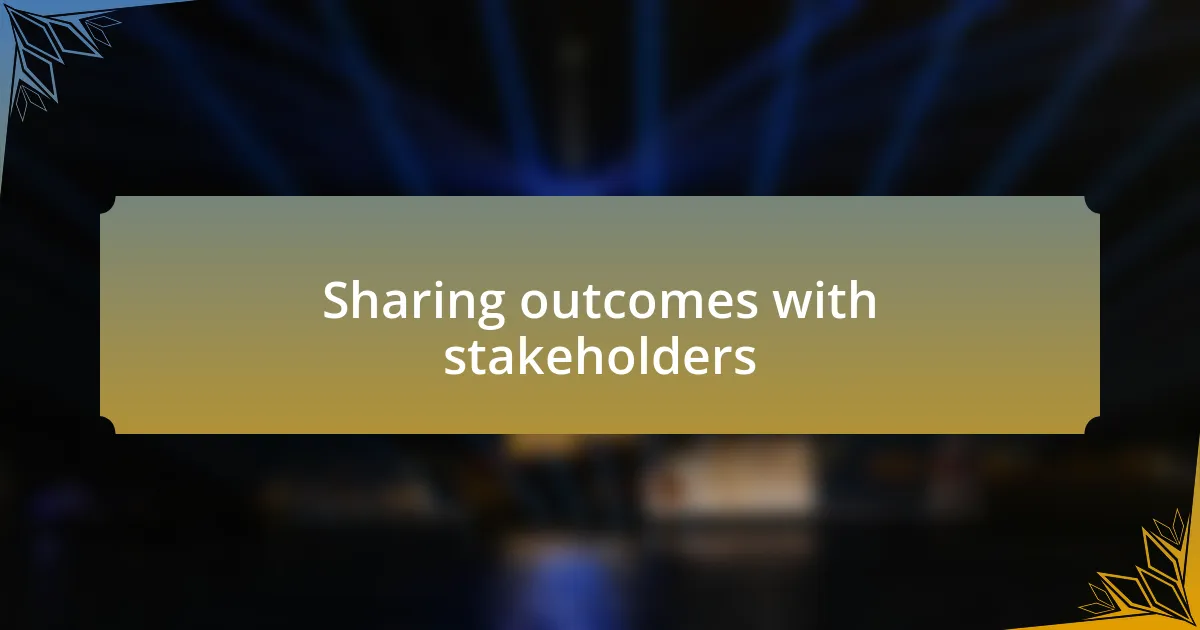Key takeaways:
- Customer feedback is crucial for product development, providing insights that can transform offerings and build trust with consumers.
- A diversified feedback collection strategy, tailored for different customer segments, enhances the understanding of user perceptions across various channels.
- Analyzing feedback reveals deeper issues and opportunities for improvements in products, emphasizing the importance of structured analysis.
- Incorporating user feedback into design and testing not only improves user experience but also fosters a sense of ownership and advocacy among customers.

Understanding customer feedback importance
Customer feedback is the gateway to understanding how consumers perceive your product. I vividly recall a time when a simple suggestion from a customer led us to a significant redesign. It made me realize that these insights are not just opinions; they are the voice of the audience that can guide the evolution of our offerings.
Isn’t it fascinating how feedback can lead to unexpected breakthroughs? I remember a session at a customer experience conference where someone shared how listening to negative reviews inspired a complete pivot in their service model. This launched their brand to new heights, reinforcing my belief that each piece of feedback, whether good or bad, is a treasure trove of information we shouldn’t overlook.
Moreover, acknowledging customer feedback builds trust and loyalty. When I personally responded to a customer’s concern, I saw firsthand how it transformed their frustration into appreciation. It’s eye-opening to realize that by showing we care about their experiences, we can cultivate deeper connections that ultimately empower product development.

Building a feedback collection strategy
Building a feedback collection strategy requires a thoughtful approach. When I first started implementing feedback mechanisms, I realized how crucial it was to tailor them to our audience. For instance, I set up quick surveys right after key customer interactions. The immediate responses helped me gauge their feelings while the experience was still fresh, which I found to be far more effective than waiting for follow-up emails.
As I progressed, I noticed the importance of diversifying feedback channels. I remember experimenting with forums and social media polls alongside traditional surveys. This not only engaged different segments of our customer base but also revealed varying perceptions across platforms. Have you ever thought about how customers might express their thoughts differently depending on the medium? This insight pushed me to adapt our collection strategy continuously, ensuring we captured a broad spectrum of feedback.
Lastly, creating a culture of feedback within the team is vital for success. I often share customer insights during team meetings, illustrating real-world impacts with specific examples. This practice fosters a shared responsibility for customer satisfaction, energizing team members to prioritize feedback in their daily tasks. I can’t stress enough how energizing it is to witness a team rallying around customer voices, feeling connected to the impact of their work.

Analyzing feedback for insights
Analyzing feedback for insights is like peeling layers from an onion. Each layer reveals something deeper about customer expectations and experiences. I vividly remember a time when we analyzed comments from a recent product launch. Initially, the feedback seemed overwhelmingly positive, but digging deeper uncovered a few critical issues that could have affected long-term satisfaction. It made me realize that what appears as glowing reviews on the surface can sometimes hide deeper frustrations. Have you experienced a situation where initial impressions didn’t tell the whole story?
Quantifying feedback can also reveal valuable trends. I once used simple metrics to track recurring themes across different surveys. When I noticed multiple customers mentioning a particular feature in their comments, I felt a sense of urgency to address it. It was as if they were collectively signaling a crossroads for product evolution. This analytical approach doesn’t just identify problems; it signals opportunities for enhancement that I might not have discovered otherwise.
When I sift through feedback, I often find it helpful to categorize responses into themes—such as usability, features, or customer support. This organization allows me to visualize patterns and prioritize changes. I can remember feeling a surge of motivation during one of these analyses when I uncovered that a new feature was not only well-received but also inspired customers to share their own creative use cases. It’s a reminder that listening deeply can transform a simple response into a wellspring of innovative ideas. How do you structure your analysis to uncover such gems?

Incorporating feedback into product design
Incorporating feedback into product design feels like weaving a tapestry. Each thread is a piece of insight from a customer, and when I bring them together thoughtfully, the final product showcases their collective vision. I recall a project where we decided to implement user suggestions directly into our design prototypes. The excitement among team members was palpable, knowing we were making tangible changes based on real user voices.
It can be surprising how minor tweaks inspired by feedback can significantly impact user experience. For instance, after implementing a design change suggested by a loyal customer, I received messages from users who found the new layout much more intuitive. That moment reminded me that sometimes, it takes just one person’s perspective to illuminate an aspect I had overlooked. Have you ever made a simple change that led to overwhelmingly positive reactions?
I also believe in the power of iterative design, where continuous feedback loops refine the product over time. I remember conducting a series of workshops with users, integrating their thoughts into every iteration of our design. This approach led us to an unexpected discovery: users not only appreciated the evolution of the product but also felt a sense of ownership in the process. Isn’t it amazing how involving customers can turn them into passionate advocates for your brand?

Testing products with real users
Testing products with real users is an exhilarating part of the development process. I vividly remember my first product test where I sat in the same room with users as they navigated our app. Their reactions—ranging from confusion to delight—were invaluable. It was eye-opening to see firsthand how they interacted with features I thought were intuitive. Have you ever experienced that moment when you realize your assumptions don’t align with reality? It’s humbling.
In another instance, we organized a testing session where real users were encouraged to vocalize their thoughts aloud while using the product. Hearing their immediate feedback helped us understand not just how they used the product, but also the emotions tied to their experiences. One user shared an emotional story about how features we designed to promote connectivity actually reminded them of lost connections. That feedback pushed us to explore deeper emotional design aspects. Isn’t it enriching when users give voice to their experiences?
Balancing user feedback with product vision can be challenging yet rewarding. For example, after a round of testing revealed that the onboarding process was too complex, I took a step back and reconsidered our approach entirely. The transformation we made was driven by users’ struggles, and it reinforced my belief: incorporating real-user testing reveals insights that can redefine our product trajectory. Have you found that sometimes, the most valuable insights come from moments of vulnerability shared by users?

Iterating based on user reactions
Iterating based on user reactions is where the magic often happens in product development. I once encountered a situation where a user hesitated at a critical junction in our app; their pause spoke volumes. It made me realize that even small design elements could significantly impact user confidence. Have you ever noticed how an overlooked detail can derail the entire experience?
One of my most enlightening moments occurred after gathering user feedback where they expressed frustration over a particular feature’s placement. Instead of defending our design choices, I took their concerns to heart. We made subtle adjustments based on their insights, and I couldn’t believe the immediate positive shift in their engagement. It was a reminder that listening can be more powerful than insisting on our original vision. Isn’t it fascinating how a simple tweak can foster a more intuitive interaction?
In another iteration cycle, I remember a user who passionately critiqued our navigation. Rather than dismissing their feedback, I embraced it fully, leading to a collaborative brainstorming session with the team. What emerged was an innovative solution that not only addressed the user’s concerns but also aligned with our long-term goals. This experience reinforced an essential truth: iterating based on real user reactions can turn frustration into opportunity, if only we remain open to the insights they offer.

Sharing outcomes with stakeholders
When it comes to sharing outcomes with stakeholders, transparency is key. I remember presenting our findings from a recent feedback session to the team; their initial skepticism was palpable. However, as I detailed how user insights reshaped our approach, their expressions shifted toward intrigue and acceptance. Isn’t it amazing how a well-articulated outcome can change the atmosphere in a room?
Being open about how user feedback impacts our product decisions not only builds trust but also strengthens our collaboration. I once shared a story of a user who felt overwhelmed by our features during a demo meeting. That moment not only struck a chord with stakeholders but also encouraged them to empathize with our users. This connection transformed our discussion, driving home the point that our development should reflect real user experiences.
I’ve found that visual storytelling can enhance the way we communicate outcomes. After gathering user data, I crafted a simple yet impactful infographic to illustrate the journey from feedback to features implemented. The stakeholders were engaged and excited; they could see the tangible results of our efforts. Have you ever tried using visuals to drive your message home? It’s a powerful method that not only conveys complex ideas but also keeps everyone aligned on the common goal of enhancing user experience.